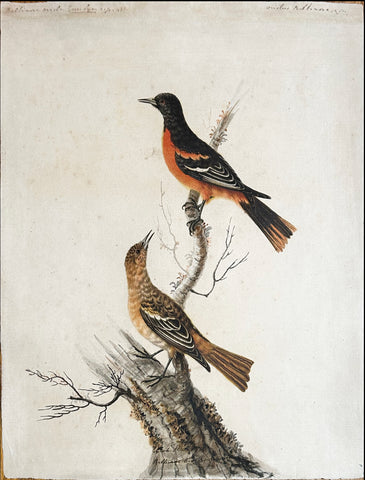
Sarah Stone (British, 1760 - 1844), Baltimore Orioles
Sarah Stone (British, 1760 - 1844)
“Baltimore Orioles”
Watercolor and ink on paper, a touch of gum Arabic
Inscribed “Sarah Stone 1785 Baltimore Birds N. America” lower center. “Baltimore Oriole..” upper left. And, “Oriolus Baltimore Lin” upper right.
Paper size: 17 7/8 x 13 5/8 inches Housed in a red cloth clamshell
The Baltimore orioles would have been among the American “curiosities” of the Museum. Stone’s depiction of them in 1785 is one of the few illustrations of North American birds from this period.
The Baltimore oriole was one of the many bird species originally described by Carl Linnaeus in the 1758 10th edition of his Systema Naturae, where it was given the binomial name of Coracias galbula.
Like all New World orioles, this species is named after an unrelated, physically similar family in the Old World: the Oriolidae. “Oriole” ultimately derives from Latin aureolus, “golden.” The genus name Icterus is from Ancient Greek ikteros, a yellow bird, usually considered the Eurasian golden oriole, the sight of which was thought to cure jaundice. The specific galbula is the Latin name for a yellow bird, again usually assumed to be the golden oriole.
Sarah Stone (British, 1760-1844)
Sarah Stone is synonymous with the Lever Museum (also known as the Leicester House), a significant cultural phenomenon of 18th-century London. Sir Ashton Lever employed this fine female artist to record specimens and ethnographic material brought back by British expeditions to Australia, the Americas, Africa, and the Far East in the 1780s and 1790s- perhaps most significant being Captain Cook on his round-the-world voyages. Stone’s meticulous paintings provide a unique record of the discoveries made by sailors and naturalists onboard British survey ships and the new colonies. They were also incredibly beautiful and technically accurate.
Sarah’s drawings’ importance lies in the fact that she not only recorded so many new scientific discoveries for the first time, but she also documented them while they were still under one roof. Throughout her nearly 30 year career, she was extremely prolific, painting over 1,000 watercolors of mounted birds, mammals, fishes, insects, reptiles, shells, minerals as well as ethnographical artifacts. Consciously she was known to sign and date many of her watercolors. Lever either purchased or was gifted the first specimens ever recorded or known to science in several fields. Unfortunately, his museum no longer exists; contents dispersed in 1806. Many of its examples have been lost forever. As a result, Stone’s paintings act as aesthetically beautiful works of art and provide an essential record of specimens used by naturalists in the age of Linnaeus, some of which are now extinct.
Only about 900 of her paintings exist today. However, they were often requested to be engraved for illustrations in natural history publications. By 1789 she was well known in London both to the public who visited the famous Lever museum as well as to the experts of the day. They were interested in natural history and everything to do with the voyages of Captain Cook. While she painted all of her subjects with a keen eye, it was thought that her drawings of birds, in particular, showed a considerable amount of technical skill. She was self-taught, and her talents were clearly innate. However, her father was a fan painter, working somewhat in the style of the French Rococo artist Antoine Watteau. Fan painting requires superb and accurate coloring skills, and map colorists often did this intricate and delicate job. As a child, Sarah learned to use local and even household ingredients for her pigments - brickdust, or the juice of leaves or flower petals. Later, Sarah used these skills in selecting the colors prompting her to work with colors that she considered permanent: Chinese white, ivory black, burnt sienna, Vandyke brown, yellow ochre, chrome lemon and yellow, light orange cadmium, vermilion, carmine, madder lake, Veronese green, sap green, cobalt, ultramarine and Prussian blue. She also employed gum Arabic to gouache powders, and she learned to mix watercolor paint and add white for opacity and highlights. Her consistent techniques only enhanced the appearance of her artwork.
Stone diligently recorded and was highly faithful (to use an 18th-century term) when she portrayed her subjects, painstakingly documenting the models in front of her. Had she employed more artistic license, some of her forms would have come across more naturalistic, but she stayed true to how the taxidermists arranged the subjects. Her works, therefore, can also be read as a historical analysis of 18th century taxidermic practices. When Sarah provided tree branches as part of her background, as we see in this fine example, they were distinctive hallmarks of her work. They were nearly depicted as pale grey or silver, like silver birch bark, with a little lichen, very delicately traced.
It is clear to see how influential Sarah Stone is to the history of natural history illustration and the tremendous skill required to paint such diverse subjects, both zoological and ethnographical. This example is an extraordinary opportunity for a collector to own an original work by this esteemed artist. We can admire this piece’s delicacy of the brushwork and her touch when it comes to color. The result has a brilliance and sheen that hardly reads as if it dates from the 18th century.
or by email at loricohen@aradergalleries.
We Also Recommend





